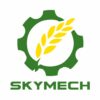In forestry management, the durability of equipment accessories such as mulcher, shredders and wood grinders, especially those that come into direct contact with materials, is crucial to work efficiency. A key strategy to extend the life and performance of these wear-part is through the use of wear-resistant overlays and carbide particle-enhanced overlays. This article explores the differences, suitable applications, and cost implications of these two types of overlays to help you make informed decisions.
Exploring Wear-Resistant Overlays
Wear-resistant overlays are coatings applied to equipment surfaces to improve their resistance to abrasion and wear. Common materials used include chromium carbide and boron carbide. These overlays are particularly effective in environments with moderate wear and minimal impact.

Benefits of Wear-Resistant Overlays
- Increased Durability: Protects equipment from wear, extending its operational life.
- Cost-Effective: Lower initial cost compared to alloy particle-enhanced overlays.
- Easy Maintenance: Simple reapplication process when the overlay wears down.
Limitations of Wear-Resistant Overlays
- Limited Impact Resistance: Not ideal for environments with high-impact conditions.
- Regular Maintenance: Requires frequent inspections and reapplications to maintain effectiveness.
Exploring Alloy Particle-Enhanced Overlays
Alloy particle-enhanced overlays incorporate hard particles like tungsten carbide into the base material (e.g., chromium carbide or boron carbide), significantly improving wear and impact resistance. These overlays are designed for harsh conditions where equipment faces both high wear and impact.

Benefits of Alloy Particle-Enhanced Overlays
- Superior Wear Resistance: Provides excellent protection in extreme conditions.
- High Impact Resistance: Ideal for applications involving heavy impacts and abrasive materials.
- Extended Maintenance Intervals: Less frequent reapplication needed, reducing downtime.
Limitations of Alloy Particle-Enhanced Overlays
- Higher Initial Cost: More expensive due to the inclusion of hard particles and complex application process.
- Application Complexity: Requires specialized equipment and expertise for proper application.
Comparative Analysis
To illustrate the differences and help you decide, let’s compare the two types of overlays in practical forestry applications.
Example 1: Forestry Mulcher Teeth

| Feature | Wear-Resistant Overlay | Alloy Particle-Enhanced Overlay |
|---|---|---|
| Material | Chromium carbide | Tungsten carbide in chromium carbide |
| Performance | Good wear resistance | Superior wear and impact resistance |
| Durability (Hours) | 200-300 | 400-600 |
| Initial Cost (per set) | $200 | $400 |
| Maintenance Cost (per cycle) | $100 | $50 |
Suitable Scenarios
- Wear-Resistant Overlay: Moderate wear conditions (soft soil, light vegetation).
- Alloy Particle-Enhanced Overlay: Harsh environments (rocky terrain, heavy vegetation).
Example 2: Wood Grinder tip

| Feature | Wear-Resistant Overlay | Alloy Particle-Enhanced Overlay |
|---|---|---|
| Material | Boron carbide | Tungsten carbide in boron carbide |
| Performance | Excellent wear resistance | Exceptional wear and impact resistance |
| Durability (Hours) | 500-700 | 800-1000 |
| Initial Cost (per set) | $300 | $600 |
| Maintenance Cost (per cycle) | $150 | $75 |
Suitable Scenarios
- Wear-Resistant Overlay: Consistent, low-impact wood grinding tasks (softwood processing).
- Alloy Particle-Enhanced Overlay: Heavy-duty wood grinding (hardwood, mixed debris).
Cost-Benefit Analysis
While alloy particle-enhanced overlays have a higher initial cost, their extended durability and reduced maintenance frequency can lead to significant long-term savings. Here’s a simplified cost comparison over the lifespan of the equipment:
| Overlay Type | Initial Cost | Maintenance Cost (per cycle) | Lifespan (hours) | Total Cost over 2000 hours |
|---|---|---|---|---|
| Wear-Resistant Overlay | $200 | $100 | 200-300 | $200 + ($100 * 6.67) = $867 |
| Alloy Particle-Enhanced Overlay | $400 | $50 | 400-600 | $400 + ($50 * 3.33) = $567 |
Decision-Making Process
- Evaluate Work Conditions: Assess the specific working conditions and demands of your forestry operations.
- Determine Budget Constraints: Balance the initial investment with long-term maintenance budgets.
- Performance Requirements: Identify whether your primary concern is wear resistance alone or a combination of wear and impact resistance.
Conclusion
Choosing between wear-resistant overlays and alloy particle-enhanced overlays depends on your specific needs and operating conditions. Wear-resistant overlays are cost-effective and suitable for moderate wear environments, while alloy particle-enhanced overlays offer superior durability and impact resistance for harsher conditions. By carefully evaluating your requirements and conducting a cost-benefit analysis, you can make an informed decision that maximizes the efficiency and lifespan of your forestry equipment.
Tip: wear part can be displayed on our video website on YouTube


